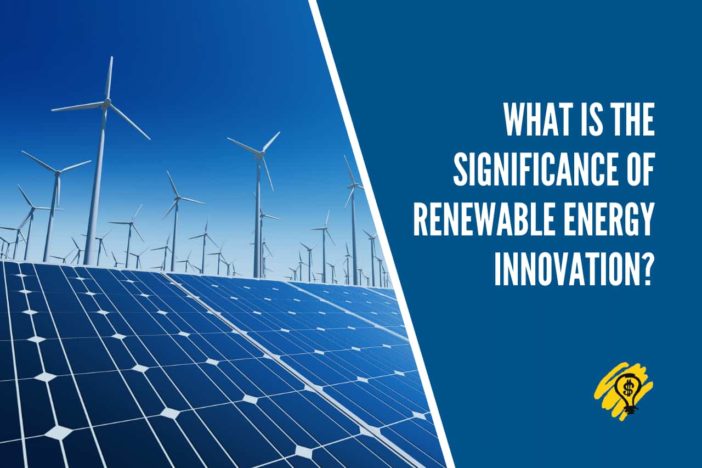There’s no better example of innovation than the advent of renewable energy. From wind turbines and solar panels to fuel cells and hydropower, we’ve seen how innovations in this space are helping us address some of our most pressing energy issues—while creating sustainable economic opportunity.
Renewable energy innovation is crucial for the future of our planet. It has the power to transform the world by providing clean and sustainable energy sources for billions of people living on the planet today. And yet, this transformative potential is often overlooked. We need to change this reality. In fact, we need to change our reality.
We must find new, renewable energy sources that don’t produce greenhouse gases and contribute to climate change. Renewables are also crucial for creating jobs and economic growth. So, what is the significance of renewable energy innovation? It’s everything.
What precisely is renewable energy, and why is it so important to invest in it?
Renewable energy is generated from natural sources that are constantly replenished, such as the sun, wind, water, and geothermal heat. Non-renewable energy sources, like fossil fuels, are finite and eventually run out. Renewables are also much cleaner for the environment – they don’t produce harmful emissions or pollute the air and water.
Investments in innovation renewable energy sources are crucial for this reason. We need to find new ways to generate energy from renewable sources to decrease our reliance on fossil fuels and safeguard the environment for future generations.
Investing in renewable energy innovation is good for the economy too. It creates jobs in the renewable energy sector and stimulates economic growth. One of the world’s fastest-growing sectors is renewable energy.
Solar, wind, and hydropower as examples
Solar power is created by transforming sunlight into electricity using solar panels. Solar panels are photovoltaic cells that absorb sunlight and generate an electric field. This field causes electrons to flow and generates a direct current (DC). The DC can convert into alternating current (AC), the type of electricity used in our homes and businesses.
Wind power is generated using wind turbines to convert wind kinetic energy into electricity. Wind turbines use their blades to capture wind and spin a shaft connected to a generator. The generator then produces electricity.
Hydropower is generated using water turbines to convert the kinetic energy of moving water into electricity. Water turbines work by capturing the energy of moving water and using it to spin a shaft connected to a generator. The generator then produces electricity.
How has renewable energy technology progressed over the years, and where is it headed in the future?
Renewable energy technology has advanced dramatically in recent years. We’ve seen advances in solar, wind, hydropower, and other renewable technologies.
Solar power is now cheaper than ever, thanks to advancements in solar panel technology. Wind turbines are also getting more extensive and more efficient. And we’re seeing new developments in renewable energy storage, which is crucial for integrating renewables into the grid.
In the future, we need to continue investing in renewable energy innovation to find new and improved methods of producing renewable energy. We also need to focus on making renewables more affordable so everyone can benefit from this clean technology.
What are some of the obstacles that this industry is facing?
The renewable energy industry faces many challenges. One is the high upfront cost of investing in renewables. Another challenge is that renewables are often intermittent, meaning they don’t produce energy constantly. It can make it challenging to integrate renewables into the grid.
However, despite these challenges, the renewable energy industry is growing rapidly and progressing on both fronts. Costs are decreasing as technology advances, and innovations are helping to make renewables more dispatchable.
What are some benefits of using renewable energy sources instead of traditional methods like fossil fuels or nuclear power plants?
There are multiple advantages to using renewable energy sources instead of traditional fossil fuels or nuclear power plants.
- Renewables are much cleaner for the environment. They don’t produce harmful emissions or pollute the air and water.
- Additionally, renewables are a sustainable source of energy that will never run out.
- Another significant benefit of renewable energy is that it creates jobs and stimulates economic growth. And as more countries transition to renewables, this trend will only continue.
What steps should be taken to boost investment in renewable energy innovation?
A few things need to be done to increase investment in renewable energy innovation.
- First, it’s essential to create policies that incentivize investment in renewables.
- Second, we need to continue to research and develop new renewable technologies.
- And third, we need to make renewable energy more affordable so that more people can benefit from this clean technology.
By taking these steps, we can ensure that the renewable energy industry continues to grow and thrive and that we keep progressing toward a cleaner, more sustainable future.
How can we ensure renewables become a more prominent part of our energy infrastructure in the future?
We must continue investing in renewable energy innovation to ensure renewables become a more prominent part of our energy infrastructure. We need to find new and improved ways to generate clean energy, and we also need to make renewables more affordable so that everyone can benefit from this clean technology.
Conclusion
Renewable energy is crucial for finding new and improved ways to generate clean energy. It’s also essential to make renewables more affordable so everyone can benefit from this clean technology. By continuing to invest in renewable energy innovation, we can ensure that renewables play a significant role in our energy future.





